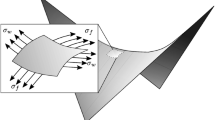Abstract
This paper proposes a convenient numerical form-finding method for designing the minimal surface, or the equally tensioned surface of membrane structures with specified arbitrary boundaries. Area minimization problems are formulated as a distributed-parameter shape optimization problem. The internal volume or the perimeter is added as a constraint according to the structure type such as a pneumatic or a suspension membrane. It is assumed that the membrane is varied in the out-of-plane and/or the in-plane direction to the surface. The shape sensitivity function for each problem is derived using the material derivative method. The minimal surface is determined without shape parameterization by the free-form optimization method, a gradient method in the Hilbert space, where the shape is varied by the traction force in proportion to the sensitivity function under the Robin boundary condition. The calculated results show the effectiveness and practical utility of the proposed method for optimal form-finding of membrane structures.




















Similar content being viewed by others
References
Azegami H (1994) A solution to domain optimization problems. Trans Japan Soc Mech Eng 60:1479–1486. (in Japanese)
Bletzinger KU, Wuchner R, Daoud F, Camprubi N (2005) Computational methods for form finding and optimization of shells and membranes. Comput Methods Appl Mech Eng 194(30–33):3438–3452
Bletzinger KU, Firl M, Linhard J, Wuchner R (2010) Optimal shapes of mechanically motivated surfaces. Comput Methods Appl Mech Eng 199(5–8):324–333
Braibant V, Fleury C (1984) Shape optimal design using b-splines. Comput Methods Appl Mech Eng 44(3):247–267
Choi KK, Kim NH (2005) Structural sensitivity analysis and optimization 1. Springer
Gray A (1998) Modern differential geometry of curves and surfaces with MATHEMATICA. CRC Press
Linkwitz K (1999) About formfinding of double-curved structures. Eng Struct 21(8):709–718
Monterde J (2004) Bézier surfaces of minimal area: the Dirichlet approach. Comput Aided Geom Des 21(2):117–136
Meyer M, Desbrun M, Schroder P, Barr A H (2002) Discrete differential-geometry operators for triangulated 2-manifolds. Vis Math III:35–57
Otto F (1973) Tensile structures. MIT Press
Pan Q, Xu G (2011) Construction of minimal subdivision surface with a given boundary. Comput-Aided Des 43:374–380
Shimoda M, Azegami H, Sakurai T (1998) Traction Method approach to optimal shape design problems, SAE 1997 transactions. Journal of Passenger Cars, Section 6(106):2355–2365
Shimoda M, Tsuji J (2006) Non-parametric shape optimization method for rigidity design of automotive sheet metal structure, SAE 2006 Transactions. Journal of Passenger Cars - Mechanical Systems, Paper No. 2006-01-0584, pp 483-492
Shimoda M, Liu Y (2014) A Non-parametric free-form optimization method for shell structures. Struct Multidiscip Optim. 10.1007/s00158-014-1059-1
Shimoda M, Liu Y, Morimoto T (2014) Non-parametric free-form optimization method for frame structures. Struct Multidiscip Optim 50(1):129–146
Shimoda M, Azegami H, Sakurai T (1995) shape optimization of linear elastic structures subject to multiple loading conditions. Current Topics in Computational Mechanics 305:319– 326
Acknowledgments
A part of this research was supported by grants in-aid from the Research Center of Smart and Tough Machines at the Toyota Technological Institute.
Author information
Authors and Affiliations
Corresponding author
Rights and permissions
About this article
Cite this article
Shimoda, M., Yamane, K. A numerical form-finding method for the minimal surface of membrane structures. Struct Multidisc Optim 51, 333–345 (2015). https://doi.org/10.1007/s00158-014-1127-6
Received:
Revised:
Accepted:
Published:
Issue Date:
DOI: https://doi.org/10.1007/s00158-014-1127-6




